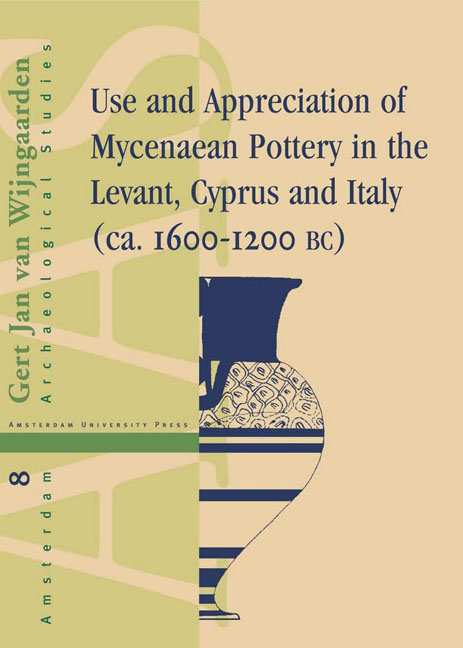2 - Mycenaean Pottery in the Mediterranean
Published online by Cambridge University Press: 10 February 2021
Summary
INTRODUCTION
The data-set on which this study focusses, consists of Mycenaean pottery in areas beyond the Aegean. Catalogue I presents a list of sites in the Mediterranean where such pottery has been found. Considering the large differences between sites and areas in the intensity of archaeological research and publication, this list should be understood as much a result of archaeological research (including my own) as an indicator of the distribution of Mycenaean pottery.
Stylistically, the body of ceramic material under study ranges from LH I to LH IIIB2. The absolute chronology of the Aegean stylistic ceramical phases is by no means undisputed. The chronological frameworks in the Levant, Cyprus and Italy depend to a considerable extent on the stylistical classifications of the Mycenaean pottery. As a result, the interdependant absolute chronological frameworks are all hotly debated. For this reason, I will generally refrain from using absolute dates. A provisional chronological chart based on the traditional view is given in figure 2.1.
THE CHARACTER OF MYCENAEAN POTTERY FOUND OUTSIDE G REECE
Mycenaean pottery, as a class of archaeological artefacts, is very well studied indeed. Already in early studies it was realised that the corpus of Mycenaean pottery found outside the Aegean differs in several respects from that found on the Greek mainland. One of the most readily apparent differences is that wheel-made, decorated fine wares constitute a far larger proportion of the material than in the Aegean. In fact, with a few notable exceptions, undecorated coarse ware and plain fine wares imported from Mycenaean Greece are almost non-existent in most areas. Other differences are visible in the range of pot shapes found in the eastern and central Mediterranean. The occurrence in Cyprus, and to a lesser extent in the Levant, of vessel types which are rare in Greece led to the term Levanto- Helladic ware, to indicate a group of pot shapes believed to have been produced in Cyprus. Shallow bowls (FS 295-296), chalices (FS 278), angular jugs (FS 139), amphoroid kraters (FS 53-55) and zoomorphic rhyta were all believed to belong to this class. The Mycenaean pottery with pictorial decoration, likewise found more often in the eastern Mediterranean than in Greece, was believed to belong to this class of Levanto-Helladic ware as well.
- Type
- Chapter
- Information
- Use and Appreciation of Mycenaean Potteryin the Levant, Cyprus and Italy (1600-120O BC), pp. 9 - 22Publisher: Amsterdam University PressPrint publication year: 2002

